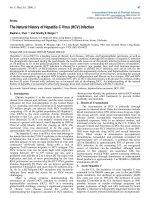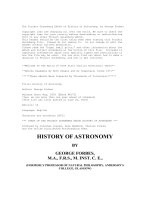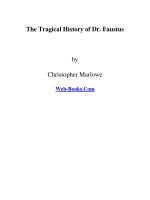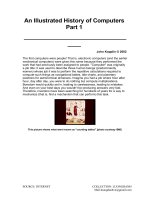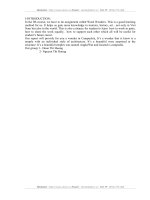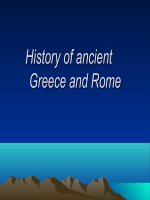history of physics
Bạn đang xem bản rút gọn của tài liệu. Xem và tải ngay bản đầy đủ của tài liệu tại đây (673.79 KB, 81 trang )
A “Brief” History of Physics
1
Mr. Hughes
Ridgefield Memorial High School
Friday, December 2, 2016
Based on “A Brief History of Physics”
By Dean Baird, Fred Hendel, and Walter
Scheider
I. In the beginning…
2
Physics began when the first thinking
creature wondered, “why?”
Why did the rain fall at certain times?
Why was there a perpetual cycle of light
(day) and dark (night)?
I. In the beginning…
3
Why could one type of pain be remedied by
eating while many others could not be remedied
at all?
Why did females give birth and why did living
things die?
Why did things move as they did?
Why, why, why?
II. The Greeks
4
The first people to deal with these
questions on a rational basis (i.e.,
without reference to
gods or magic) were the Greeks.
II. The Greeks
5
The Greeks held the process of reasoning
in high esteem.
Experimentation was generally considered
unnecessary.
Aristotle
6
Aristotle (384-322 B.C.E.) devised
the first comprehensive explanation for
motion.
Aristotle’s explanation was based
on the concept of natural places.
Ptolemy
8
The Greeks were also fascinated by the
heavens, and Aristotle deduced that the
planets, the moon, and the sun traveled in
perfect circles around the earth.
Ptolemy (TAH leh mee) worked out an
awkward mathematical explanation of the
geocentric solar system (Ptolemaic
epicycles) in the 2nd century C.E.
III. The Copernican Revolution
10
Nicolaus Copernicus
11
The heavens continued to fascinate
those who asked “why?” and in 1543, a
Pole by the
name of Nicolaus Copernicus (14731543) suggested that the sun was at
the center of the solar system, and the
earth and other planets orbited around
it.
By then, however, the Greek view of
nature had persisted so long, it had
Copernicus was aware of the
controversy his theory would bring; he
did not publish his
work until he was near death.
A supporter of Copernicus’ heliocentric
(sun-centered) model was burned at the
stake for espousing this “heretical”
view.
Galileo was chastised and imprisoned
Johannes Kepler
14
The truth prevailed, however, and the
heliocentric model became well
established with the mathematical
work of Johannes
Kepler (1571-1630) of Germany.
IV. The Time of Galileo
16
Galileo Galilei
17
The Italian scientist Galileo Galilei
(1564-1642) is credited with
asserting the importance of
experimentation in the study of nature.
In addition to promoting Copernicus’
heliocentric model, Galileo discovered
that all objects fall at the same rate.
V. Newtonian Mechanics
20
Isaac Newton
21
Isaac Newton (1642-1727) was born
the same year that Galileo died and is
considered by many to be the greatest
physicist ever.
Newton reaffirmed Galileo’s findings
about motion.
He went on to explain the relation of
force to the resulting motion and how
objects interact.
VI. After Newton:
Electromagnetism
23
Benjamin Franklin
24
Although Newton demystified motion
and forces and gravity, he left many
wonders of
nature unexplained.
Electric charge was one.
American Benjamin Franklin (17061790)
experimented with electricity and
explained a great deal of the behavior
of electric charge.


